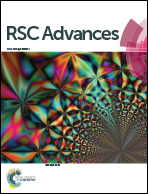Synthesis of a borylated boron–dibenzopyrromethene dye enabling the visual detection of H2O2 vapor†
Abstract
Given our interest in the development of reaction-based chemosensors, we developed a novel boron–dibenzopyrromethene dye with a pinacolboryl group (1), blue in color (λmax = 621 nm, ε = 8.74 × 104 M−1 cm−1) with red emission (λmax = 643 nm, λex = 550 nm) in THF. H2O2-mediated oxidation of the pinacolboryl group was found to induce a significant fluorescence decrease at 642 nm (λex = 550 nm) in EtOH/H2O (1 : 1 v/v) at 25 °C, enabling us to detect trace levels of H2O2 visually. The time-dependent response was investigated to evaluate the pseudo-first-order rate constant of 1.69 min−1 under basic conditions, meaning that its fluorescence was decreased by 80% in 2 min. Such a remarkable response capability motivated us to test the suitability of 1 for the detection of H2O2 vapor. For these experiments, a 1-coated TLC plate was fabricated by a spin-coating method and then placed in sealed bottles with H2O2 vapor. It was found that the increasing vapor concentration of H2O2 could be visually monitored by a change in red emission (ΔR value). Based on this, we estimated the detection limit of this method to be 8.43 ppb. We also found that the 1-coated TLC plate could selectively detect H2O2 vapor over common solvents tested.

- This article is part of the themed collection: In celebration of Seiji Shinkai's 70th Birthday

 Please wait while we load your content...
Please wait while we load your content...